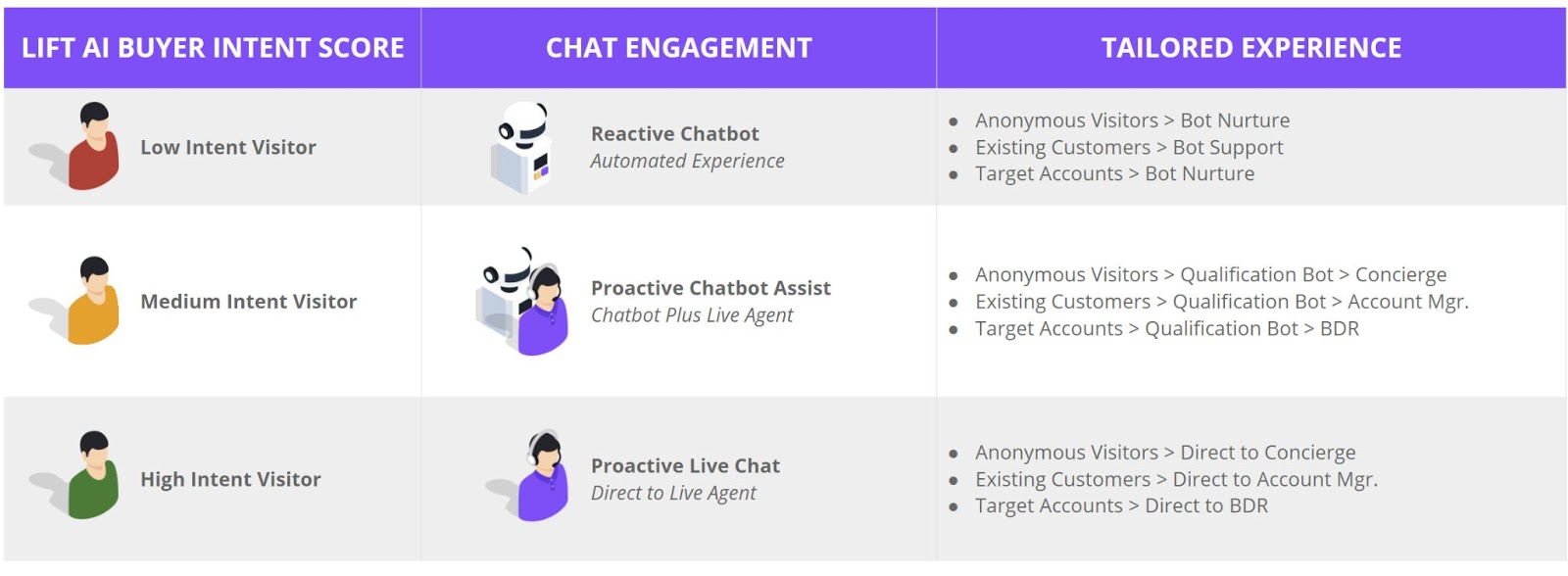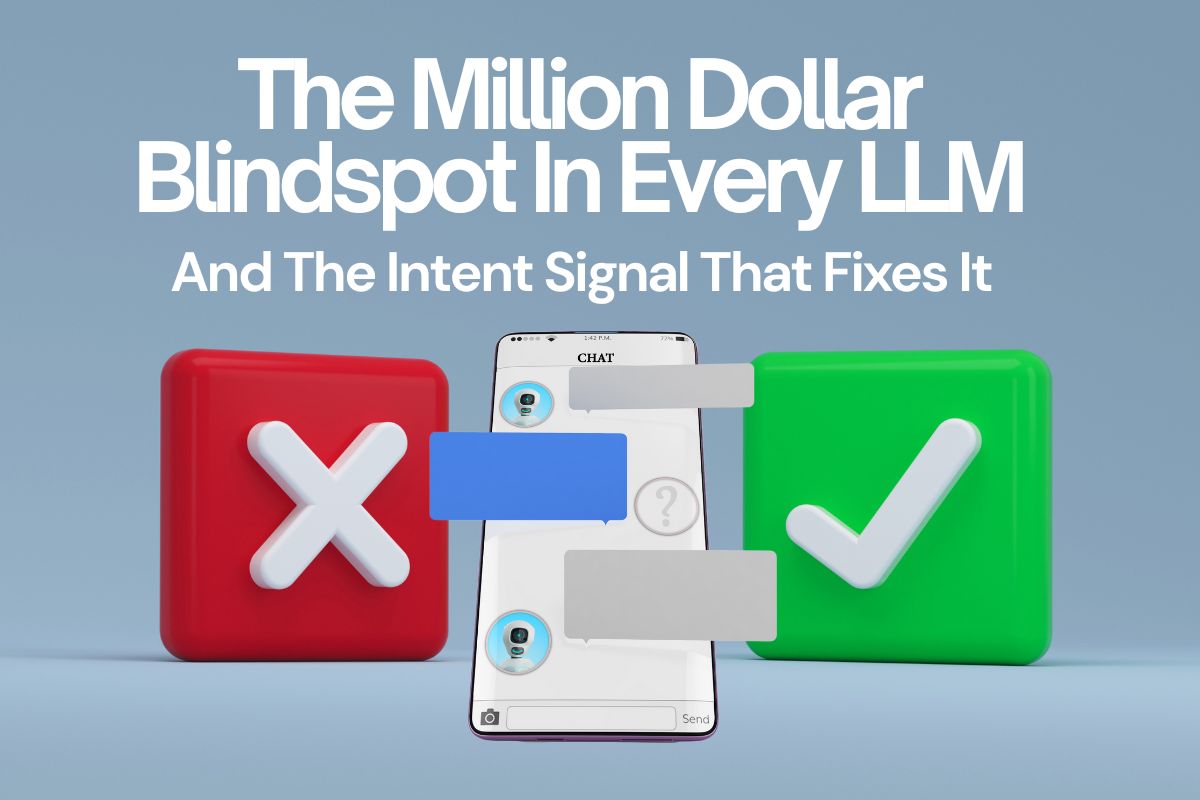Updated June 28, 2024: We’ve added more clarity to 1st party, 2nd party, and 3rd party data definitions and examples, and presented a revised solution for using it to spearhead sales.
As more companies switch to online B2B sales, buyer intent data is gaining in both popularity and importance. Successful businesses realize that having actionable data at hand related to how likely web visitors are to buy is critical.
Understanding your customers through audience data, including first-party, second-party, and third-party data, is essential for building better experiences. With accurate buyer intent data, sales and marketing teams can create tailored campaigns, personalized follow-ups, and educational content that addresses any issues that prevent your audience from buying.

Buyer intent data allows you to segment website visitors, prioritizing those with a higher chance of converting. That way, your BDRs can focus on high-buyer-intent leads and increase sales without doing any extra work.
What are the different types of buyer intent data? Where do you source it? And how do you use it to sell more?
Tip: Find the best features of 1st party, 2nd party, and 3rd party data integrated into your marketing stack with Lift AI. This solution determines the exact buyer intent of all your website visitors and lets your sales team focus on those who want to hear from you.
What Is Buyer Intent Data?
In 2020, there were 40 times more bytes of data than stars in the observable universe, measured in quintillions — and the pace of data creation worldwide continues to accelerate exponentially.
While 99% of all data online is not useful or actionable, what remains in the 1% could give you a competitive advantage if aggregated and processed in the right way.
Buyer intent data consists of interrelated data points that can be weaved together to tell a story about a particular online user.
For example, if someone searches for “CRM for small businesses,” then visits the top five CRM vendor websites and requests a demo in two of them, we can conclude that their buyer intent in relation to CRMs is high. If your company sold CRMs, this would be someone for your BDRs to prioritize in their pipeline.
However, this is a simplistic view of buyer intent data. It’s not enough to consider one or two data points to infer a visitor's buyer intent. An accurate representation would need thousands, if not millions, more.

Buyer intent data can come from a variety of online sources, including websites, search engines, social media, targeted advertising, and content consumption. Even real-life buyer intent data gathered at conferences, presentations, pitches, and meetings can be evaluated and recorded in your CRM.
We can now record more specific buyer intent actions than ever before, from keystrokes and Google searches to website browsing patterns and video plays. Buyer intent tools can then analyze this data based on recency, frequency, and engagement.
1st Party, 2nd Party, and 3rd Party Data Defined
Leveraging buyer intent data in sales can deliver a major boost to quantitative and qualitative results, both expanding the reach and improving the targeting. The process of using this type of data starts with sourcing — that’s where the distinction between 1st, 2nd, and 3rd party data becomes critical.

(Source)
Understanding and managing customer data is crucial as data collection methods evolve. This includes first-party, second-party, third-party, and zero-party data. Transparent data collection practices and prioritizing customer privacy are essential to building trust and ensuring you're following data privacy regulations like GDPR and the California Consumer Privacy Act (CCPA) when using customer data.
What is First-Party Buyer Intent Data?
First-party data relates to what you can gather internally.
For example, you collect first-party data when someone visits your website, interacts with your mobile application, or engages with your social media profiles. This data can come from various sources, including website traffic, survey responses, and customer interactions. Your BDRs generate first-party data through their efforts and record it in a CRM.
First-party data can provide the most accurate and actionable results since you control the specifications and can dial precision to get the results you need. First-party data can be acted upon immediately before it becomes outdated, which positively differentiates it from data gathered elsewhere.
A lot of first-party data is refreshable, since the same visitors tend to come back and add to previously recorded information.
All this makes first-party data affordable, reliable, and easy to convert.
There are two issues with first-party data. You need to be sure that the data comes from your ICPs (ideal customer profiles). Otherwise, the information might not be relevant to you. Another issue is that you can’t generate first-party data at scale, since you’re limited to your ad budget, website visitors, and BDR efforts.
What is Second-Party Buyer Intent Data?
Second-party data is someone else’s first-party data. You buy second-party data from partners, affiliates, data providers, and researchers that gather it themselves. For example, G2 and TechTarget are second-party data sources that include buyer intent data. Another example is when a grocery store sells its customer loyalty data to a credit card company.
The key is to ensure that the data you get is in line with your ICPs and comes from a trustworthy, current, and reliable source.
Using second-party data is a great auxiliary way to expand your reach in the market, but it’s still limited in scope compared to what third parties can provide because customer and audience data is somewhat less accurate than what you can collect yourself.
What is Third-Party Buyer Intent Data?
Third-party data comes from aggregating existing information. It’s nearly infinite and there are numerous companies that sell access to it in an organized and digestible form. This is sometimes referred to as external buyer intent data.
Aggregators get third-party data from ads, cookies, IP addresses, databases, website crawlers, chatbots, social media, press mentions, and more. Analyzing everything makes it possible to create a holistic view of how any particular customer would behave.
Companies often use a data management platform (DMP) to purchase and manage these large datasets. A DMP helps acquire third-party data from data aggregators and ensures the data is organized and compliant with privacy regulations.
Third-party data can be used to augment first-party data in interesting ways. Since first-party data shows potential customer actions directly on a specific property, third-party data can add customer actions before and after their visit.
Companies using third-party data get access to a much wider audience and are able to source new prospects on a different scale. Think thousands of leads instead of dozens.
A major downside of third-party data is its integrity. By the time it reaches you, much of the information might be outdated or inaccurate, making its targeted use much less effective.
How to Use Buyer Intent Data
What if you could scale first-party data, increase the precision of third-party data, and then merge the two to calculate buyer intent for the best results?
This impossible challenge has been solved with Lift AI.
Lift AI is the first solution to integrate first and third-party data to accurately gauge buyer intent for every single visitor on your website.

Based on a proprietary machine-learning model, Lift AI has processed more than one billion third-party data points and 14 million live sales engagements to make precise real-time buyer-intent predictions.
A customer data platform (CDP) consolidates and standardizes customer data from various sources, ensuring consistency and accuracy across all systems.
As a result, Lift AI determines the buyer intent of any visitor to your website, even if they are anonymous to you and haven’t been recorded in your CRM (which could be up to 98% of them).

Lift AI is able to do so because it leverages the direct actions of every visitor (first-party data) but compares it to a large volume of previous web interaction data collected for over 15 years across a network of websites. On average, Lift AI finds the highest buyer intent visitors (about 9% of the average traffic) with 85% accuracy.
In addition, Lift AI integrates with your marketing stack (e.g., your enterprise chat platform) and assigns a score to every website visitor. It can then flag the highest-scoring visitors to your BDR team and direct medium- and low-scoring visitors to a nurturing campaign.

The results reported by active Lift AI customers speak for themselves. PointClickCare increased its conversions by 400%, attributing over $1M in extra revenue to the Lift AI integration. Formstack grew its conversions by 420%. Other customers report anywhere from two to ten times a spike in conversions within the first 90 days.
Integrating first and third-party data is crucial for a comprehensive understanding of customer behavior. By combining these data sources, businesses can create a more detailed and accurate customer profile.
However, managing data from different systems can lead to inaccurate and inconsistent data. Leveraging a centralized platform is essential to ensure data quality and consistency across all systems.
Try Lift AI free for 30 days. No credit card is required. Just sign up and add a small JavaScript snippet to your website.






